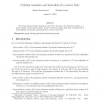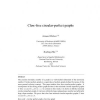22 search results - page 2 / 5 » Clique and chromatic number of circular-perfect graphs |
WG
2004
Springer
13 years 11 months ago
2004
Springer
We show how to use split decomposition to compute the weighted clique number and the chromatic number of a graph and we apply these results to some classes of graphs. In particular...
CORR
2010
Springer
13 years 6 months ago
2010
Springer
We obtain improved upper bounds and new lower bounds on the chromatic number as a linear function of the clique number, for the intersection graphs (and their complements) of fini...
ENDM
2007
13 years 6 months ago
2007
The circular chromatic number of a graph is a well-studied refinement of the chromatic number. Circular-perfect graphs is a superclass of perfect graphs defined by means of this...
COMBINATORICA
2011
12 years 5 months ago
2011
Given independent random points X1, . . . , Xn ∈ Rd with common probability distribution ν, and a positive distance r = r(n) > 0, we construct a random geometric graph Gn wi...
DAM
2006
13 years 6 months ago
2006
To a set of n points in the plane, one can associate a graph that has less than n2 vertices and has the property that k-cliques in the graph correspond vertex sets of convex k-gon...


